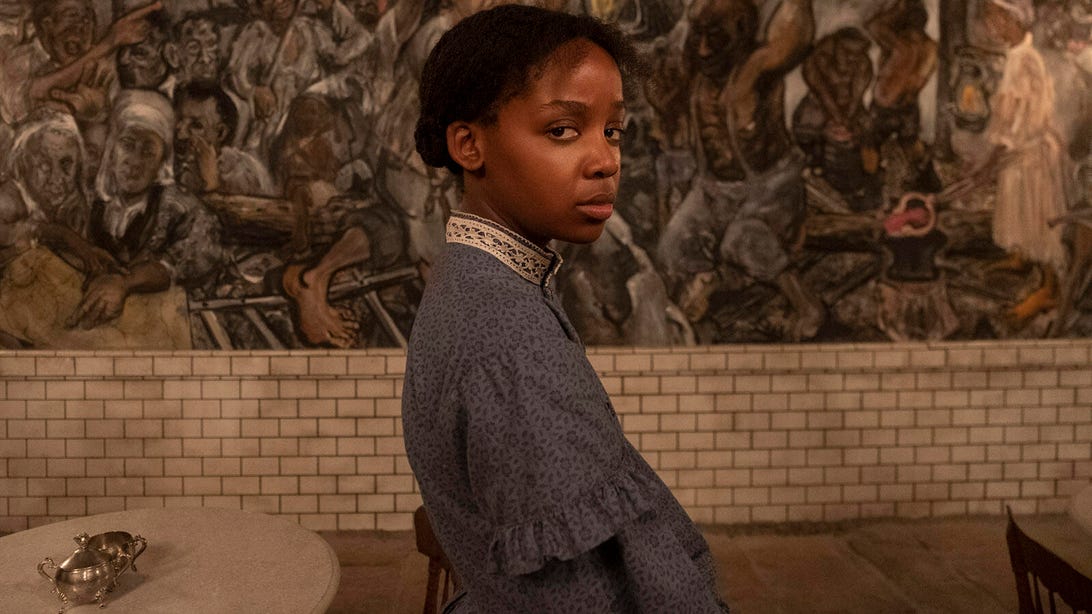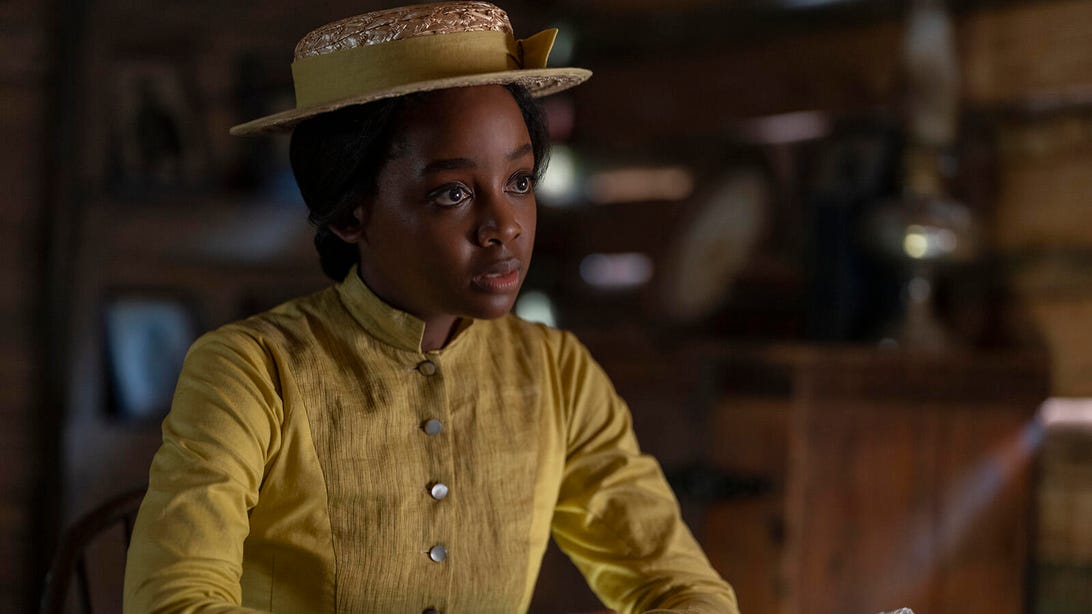Join or Sign In
Sign in to customize your TV listings
By joining TV Guide, you agree to our Terms of Use and acknowledge the data practices in our Privacy Policy.
How Barry Jenkins' The Underground Railroad Walks the Line Between Tribute and Trauma
'I can't just make art as a mathematical equation; it has to be spiritual at some level'
[Warning: The following contains light spoilers for The Underground Railroad. Read at your own risk!]
Screener episodes for Barry Jenkins' The Underground Railroad were made available to critics just a few days before the killing of Daunte Wright at the hands of a police officer in the Minneapolis suburb Brooklyn Center. Wright's death was one of at least a half dozen police-related killings to make national headlines since the murder of George Floyd sparked global Black Lives Matter protests in June 2020.
Included with the screeners was an essay from Jenkins about how difficult it was to find the right time to release his 10-episode limited series, which adapts Colson Whitehead's 2016 novel about a young slave named Cora (played on screen by Thuso Mbedu), who goes through hell and back many times over to escape the plantation and make her way to freedom. In the essay, Jenkins admitted that there would never be a good time for the series, as Black people in America are constantly under duress and experiencing trauma, and there was no way to bring Whitehead's novel to the screen without acknowledging the horrors of slavery and the pain Black American ancestors endured for over 250 years of bondage.
Jenkins and Whitehead could not tell Cora's story without tragedy or trauma, but Jenkins — who co-wrote, directed, and executive produced the series — set about making The Underground Railroad to recontextualize those painful moments, to shift the narrative around a slave story to honor those who endured the practice, rather than drawing on their suffering for entertainment. By the end of the series, Cora's story is one of hope and aspiration, but there is no small amount of suffering that Cora, those around her, and the audience have to endure before getting to the other side.
What to Stream on Hulu, Netflix, Amazon Prime, and More in May 2021
"I [was] very adamant with Colson that the only way I could do this was as a series," Jenkins told TV Guide. "I felt like the trauma and the mentality that is so triggering for audiences, justifiably so — in a feature film, those images can be so loud that they don't leave space to process much of anything else."
"I knew that we had to tell the truth about those images, but there was so much more ground to cover," said Jenkins. "Cora goes on this journey where she's taking possession of herself, and I knew that we had to create a show where there was the space to get further and further away from those images and get deeper and deeper into these, as I call them, softer images that we oftentimes don't give ourselves the space to see because these other images are so loud."
Controlling Cora's narrative meant deciding what would be depicted on screen versus relayed in exposition or dialogue. If the scene was depicted on screen, Jenkins also had to decide how explicit or graphic to be with the violence. With every act of violence, Jenkins evaluated how the incident was driving the character and what messages he was displaying to the audience at home.
"That was a really tricky process. It was a very delicate process. It was a very difficult process," he said. "Part of it was done in the moment. So for example, the first time there's any depiction of whipping in the show, I was very adamant that we weren't going to have any close-ups of whips contacting flesh in the show. The first time we show it, it's a great big wide shot at night. That was very intentional, and so you can see what you can't fully see. Then we come off that and we go from acute trauma to this trauma witnessed, and we land with the folks who were forced to witness [the whipping]."
"To me, that was working out how trauma reverberates throughout the people who are forced to witness it," Jenkins explained. "You can say, 'Well, as an audience member I'm forced to witness this trauma. How is that going to affect me?' We always try to be aware of that. In the case of that scene, if you go to our footage, that's the only shot we did. We didn't do any other coverage of this scene. It was clear that that was enough."

Thuso Mbedu, The Underground Railroad
Amazon StudiosThere were some moments that demanded a close-up look at the damage being done to the people in Cora's orbit. In the premiere episode, a runaway slave named Big Anthony is captured and tortured in front of the entire plantation, then burned alive while Cora and the other slaves are forced to watch. Jenkins' camera doesn't shy away from what's happening to Anthony, or the pain of the people having to witness it, but the writer and director found a way to give Anthony a voice in the scene rather than allowing the slavemasters all the power.
"The sequence with Big Anthony was taken from the book. In my research, these things actually happened. You look at these photos of the aftermath of lynchings from the Jim Crow era, and you see these things continued to happen," said Jenkins. "I felt like it was important to tell the truth about that happening."
"I felt like it was important to give this character agency in the moment," Jenkins continued. "So he's not just screaming. He's not just yelling out in pain and the trauma being visited to him. He's speaking to the people who were there to witness. He says, 'No more masters, no more slaves.' Then he says directly to Terrance Randall, 'God damn you. God damn you,' and we even go into his body to show that he is witnessing. These are words that are being visited upon. I felt like that was a way to get inside the image, which I felt had to be told because it's the engine that drives our characters to decide, 'You know what, this sh-- is going too far. It's enough.'"
Big Anthony's death and several others within the show definitely count as hard images, but the softer images that Jenkins referenced often come in the form of dialogue-free, panoramic shots of the characters at each of the locations Cora finds herself visiting throughout the series, like slow-motion portraits of the people imprinting on her life at each stop of her journey. Jenkins shot hours of these portrait shots, interspersing a fraction of them into the series, allowing the audience brief respites from the constant stress of Cora's continued escape from chains. The director released an additional hour of the footage ahead of the show's premiere to exhibit the Black gaze of The Underground Railroad.
In all my years of doing press, I've been repeatedly asked about the white gaze. Rarely have I been set upon about the Black gaze; or the gaze distilled.
— Barry Jenkins (@BarryJenkins) May 11, 2021
This is an answer to a question rarely asked.
An act of seeing. Of seeing THEM
More words at 👇🏿https://t.co/xY1fJs1wvm
"We can't do anything about the fact that our ancestors lived through these horrors, but if we're so triggered that we don't want to see these horrors we risk erasing our ancestors," Jenkins explained. "There were moments where I looked around and I realized, 'I am looking into the face of my ancestors, and they are looking at me. They are getting to see me.' How could they ever have imagined that we will now be sitting here, having this conversation about a work of art that is meant to honor them? I thought, 'Oh, I have to capture this.'"
Not only do the panoramic scenes offer a moment of peace, but Jenkins imagines they will allow the show's audience, specifically its Black audience, to make a connection with those who came before, to be proud of how the ancestors survived and feel their spirit through the lens of the camera. And if that connection is real, then the series and Jenkins, as its shepherd onto the screen, have done their job in a meaningful way.
"Every time we [made one of those shots], I just got this incredible feeling because two things [were] happening: One, we are getting to see our ancestors. Whether because of the advent of photography or the delay in folks who look like us being allowed access to to create portraits in our own image, we just don't have these images of ourselves," Jenkins said. "The other thing is you're looking into the camera, and then we are looking at the screen, and so we are seeing them — but in my heart, I think they are also seeing us and the fulfillment of the promise of them enduring so their descendants could have agency and have voice. When we do those shots, and it's very soft to say it, but I think that's what's happening then. I have to believe that. I can't just make art as a mathematical equation; it has to be spiritual at some level."
The Underground Railroad is now streaming on Amazon Prime Video.

Thuso Mbedu, The Underground Railroad
Amazon